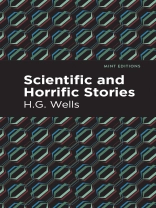Scientific and Horrific Stories is a collection of short fiction by H. G. Wells. Despite his humble beginnings as the son of English servants, H. G. Wells would become one of the most revered writers of his day.
His stories of adventure, utopia, and terror inspired such vastly different figures as Vladimir Nabokov, Winston Churchill, Jorge Luis Borges, and Sinclair Lewis. Many of his novels have been adapted for film, theater, radio, and television, including The Time Machine (1895), The Island of Doctor Moreau (1896), and The War of the Worlds (1898).
Scientific and Horrific Stories includes twenty-six tales from across Wells’ career. “The Chronic Argonauts, ” written while Wells was recuperating from an illness with friends in Stoke-on-Trent, is a story of time travel set in rural Wales that predates his beloved The Time Machine by seven years. “Æpyornis Island” is a terrifying tale of greed and survival that originally appeared in an 1894 issue of the Pall Mall Budget. Tasked with finding rare Aepyornis eggs, a rugged Englishman named Butcher ventures to a remote swamp on the island of Madagascar. When one of the eggs unexpectedly hatches, he is left stranded and at the mercy of a vicious creature that was believed to be extinct. In “The Diamond Maker, ” which also appeared in the Pall Mall Budget, a destitute man tells a wealthy businessman about his years as a maker of artificial diamonds, a time of great promise that ultimately led to his downfall.
This edition of H. G. Wells’ Scientific and Horrific Stories is a classic of English literature reimagined for modern readers.
Since our inception in 2020, Mint Editions has kept sustainability and innovation at the forefront of our mission. Each and every Mint Edition title gets a fresh, professionally typeset manuscript and a dazzling new cover, all while maintaining the integrity of the original book.
With thousands of titles in our collection, we aim to spotlight diverse public domain works to help them find modern audiences. Mint Editions celebrates a breadth of literary works, curated from both canonical and overlooked classics from writers around the globe.
Tentang Penulis
H. G. Wells (1866-1946) was an English novelist, short story writer, and social critic. Born in Kent, he was raised in a working-class family alongside three siblings. In 1874, he broke his leg and was bedridden for months, generating a lifelong devotion to reading. He was educated at a local private school until a fractured thigh ended his father’s career on the professional cricket circuit. From 1880 to 1883 Wells worked as a draper’s apprentice in Southsea, a grueling experience that would shape his outlook on society as well as inspire several of his novels. While his mother was employed as a lady’s maid at Uppark, a country house in Sussex, Wells took full advantage of the estate’s library and found particular inspiration in such classics as Plato’s Republic and Thomas More’s Utopia. Determined to get an education, Wells won a prestigious scholarship to the Normal School of Science in London, where he studied biology under Thomas Henry Huxley. Upon leaving school he struggled to find work as a teacher and turned to writing articles to supplement his income. The most productive period of his career came in 1895 following his marriage to Amy Catherine Robbins. While living in Woking, Surrey, Wells completed or worked on some of his most celebrated works of fiction, including The Time Machine (1895), The Island of Doctor Moreau (1896), and The War of the Worlds (1898). Alongside his French contemporary Jules Verne, Wells is considered one of the founding figures of modern science fiction for his tales of social unrest, utopia, time travel, alien invasion, and nuclear power. He was a committed socialist and a co-founder of The Diabetic Association, now known as Diabetes UK.












